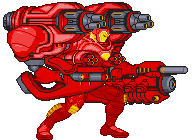
remixed by enlarging, brightening
Spiegel is known best as a computer music pioneer (see this YouTube). The image above comes from a page on her site called Early Bell Labs Computer Arts Work. The original raster painting was made in 1974.
A screen shot of her playing music on a computer instrument that looks like an Apollo moon mission console (that I put up prior to the YouTube post of her performance) and more about her music here.

